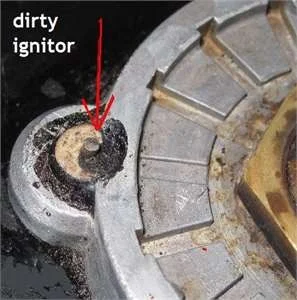When you encounter issues with your oven’s flame, it can disrupt your cooking and baking routines. In this comprehensive guide, we’ll explore common problems related to gas oven flames and provide step-by-step solutions to help you get your oven back to its optimal performance.
The Importance of a Reliable Gas Oven Flame
The gas oven flame is the heart of your oven, responsible for generating the heat required to cook and bake your favorite dishes. A steady, even flame is essential for precise temperature control and consistent results. When the flame falters or exhibits irregular behavior, it can lead to undercooked or overcooked meals and a frustrating cooking experience.
Common Signs of Gas Oven Flame Issues
Before we delve into troubleshooting, it’s crucial to recognize the signs that your gas oven flame might be experiencing problems:
- Weak or Uneven Flame: The flame may appear weak or uneven, resulting in uneven cooking and longer cooking times.
- Yellow or Irregular Flame: A healthy gas oven flame should burn blue. If you notice a yellow or flickering flame, it indicates a combustion issue.
- No Flame or Ignition Issues: Sometimes, the oven may fail to ignite or maintain a flame. This can be due to ignition problems or gas supply issues.
- Excessive Flame or Overheating: An oven flame that burns too high or produces excessive heat can lead to overcooked dishes and even safety concerns.
Now, let’s address these common gas oven flame problems and guide you through the troubleshooting process.
Common Gas Oven Flame Problems
1. Weak or Uneven Flame
A weak or uneven flame can result from various issues, including gas supply problems, burner blockages, or air shutter misalignment.
Troubleshooting:
- Inspect the gas supply and regulator for issues.
- Examine the burner and igniter for blockages or damage.
- Adjust the air shutter to achieve a proper air-to-gas mixture.
- Regularly clean burners and ports to ensure even flames.
2. Yellow or Irregular Flame

A healthy gas oven flame should burn blue, indicating proper combustion. A yellow or flickering flame can indicate combustion issues, such as insufficient oxygen.
Troubleshooting:
- Check for obstructions in the burner ports and clean them thoroughly.
- Adjust the air and gas mixture to achieve a blue flame.
- Replace any worn-out components contributing to irregular combustion.
3. No Flame or Ignition Issues
If your oven fails to ignite or maintain a flame, it can be due to problems with the igniter, gas valve, or gas line.
Troubleshooting:
- Prioritize safety by disconnecting the gas supply and ensuring proper ventilation.
- Inspect the igniter for signs of wear or malfunction, and replace it if necessary.
- Check the gas valve and control panel for issues.
- Examine the gas line and verify that gas is reaching the oven.
4. Excessive Flame or Overheating
An oven flame that burns too high or produces excessive heat can result from problems with the thermostat, gas pressure, or poor ventilation.
Troubleshooting:
- Calibrate the oven thermostat if it’s causing overheating issues.
- Regulate gas pressure to prevent excessively high flames.
- Ensure proper ventilation and airflow around the oven.
Safety Precautions and Maintenance
When dealing with gas appliances, safety should always be your top priority. Troubleshooting gas oven flame issues can involve working with gas connections and electrical components, which require careful attention to safety guidelines.
1. Prioritize Safety
Before you start troubleshooting or attempting any DIY repairs, consider the following safety precautions:
- Gas Supply: Always begin by turning off the gas supply to your oven. Locate the gas shut-off valve and ensure it is in the “off” position. This step prevents any gas from flowing to the oven during the troubleshooting process.
- Proper Ventilation: Ensure your kitchen is well-ventilated. Open windows or use exhaust fans to disperse any gas that might have accumulated.
- Gas Odor: If you detect a strong gas odor in your kitchen, evacuate the area immediately. Do not attempt any repairs if you suspect a gas leak. Contact your gas company or emergency services to address the issue.
- Disconnect Power: Unplug your oven from the electrical outlet to avoid any electrical hazards.
- Professional Assistance: If you are unsure about any aspect of the repair process, it’s wise to seek professional assistance. Gas appliances can be dangerous if mishandled.
2. Regular Maintenance Practices
Preventive maintenance can go a long way in avoiding gas oven flame problems. Here are some maintenance practices you can incorporate into your routine:
- Clean Burners and Ports: Periodically clean the burners and their ports. Accumulated debris, grease, or dust can obstruct proper combustion. Use a soft brush or cloth to ensure they are free from blockages.
- Inspect Components: Regularly inspect key components such as the igniter, burner, and thermostat for any signs of wear or damage. If you notice any issues, address them promptly.
- Ventilation: Ensure that the oven’s ventilation system is clear and functioning correctly. Check for any obstructions or blockages in the vent area.
- Calibrate Thermostat: If you notice temperature inconsistencies in your oven, consider calibrating the thermostat. This simple adjustment can ensure your oven cooks at the right temperature.
- Professional Checkups: Periodically, have your gas oven inspected by a professional technician. They can perform a comprehensive check to identify and address any potential issues before they become major problems.
By following these safety precautions and incorporating regular maintenance practices, you can reduce the risk of gas oven flame issues and ensure a safer cooking environment. Safety and maintenance are essential for the longevity and performance of your gas oven.